Business Economics Report: Law of Demand, Supply and Emerging Theories
VerifiedAdded on 2023/01/12
|12
|3229
|89
Report
AI Summary
This report provides a comprehensive analysis of business economics, focusing on microeconomic concepts such as the law of demand and supply. It examines the factors that influence demand and supply curves, including disposable income, price of related goods, taste and preference, cost of production, and technology, using Tesco Plc as a case study. The report also explores emerging economic theories, including behavioral economics and nudge theory, comparing and contrasting them with 20th-century economic models. The analysis includes diagrams illustrating the movement along and shifts in the demand and supply curves, providing a detailed understanding of the market dynamics and their impact on business practices. The report concludes with a summary of the key findings and their implications for modern business strategies.
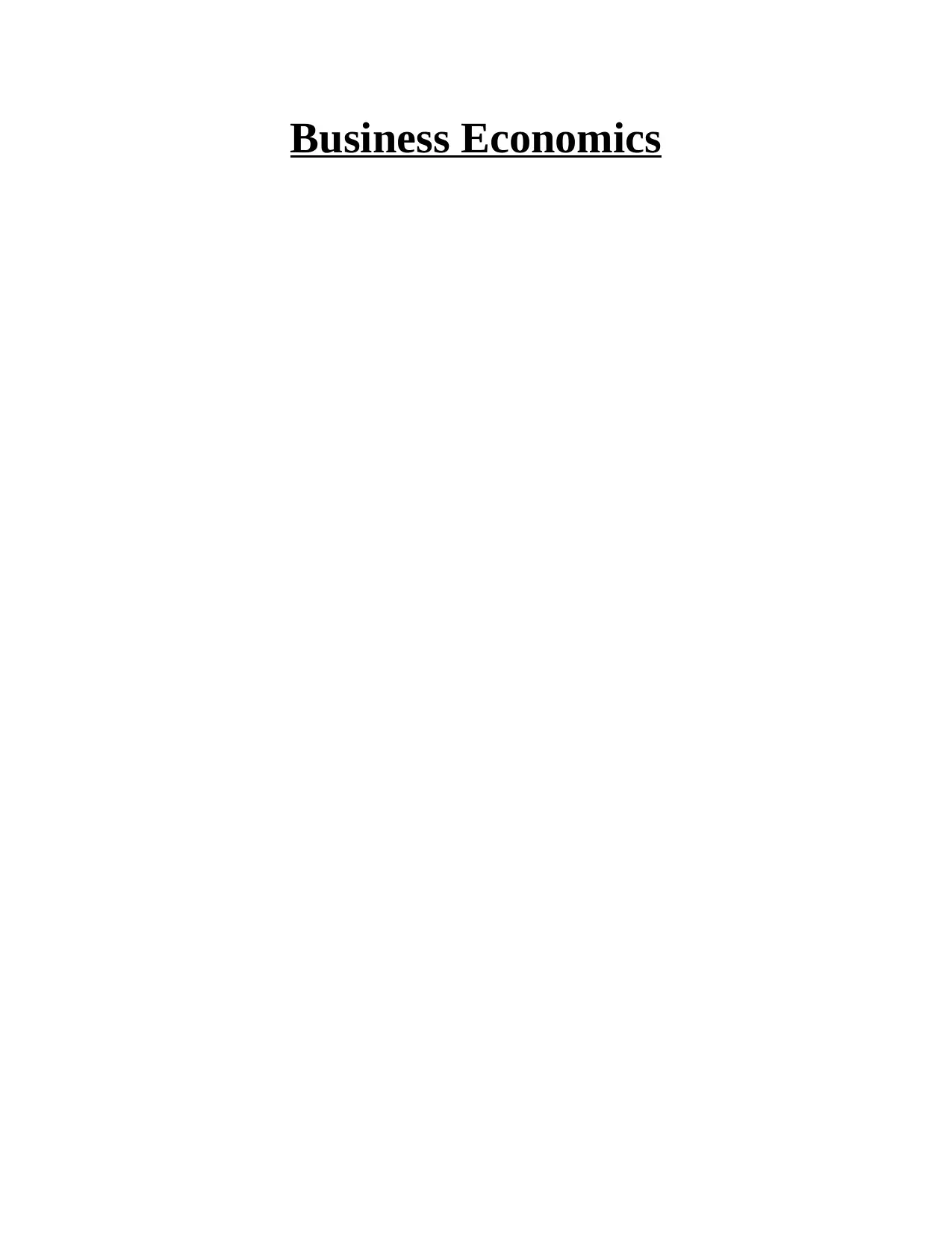
Business Economics
Paraphrase This Document
Need a fresh take? Get an instant paraphrase of this document with our AI Paraphraser
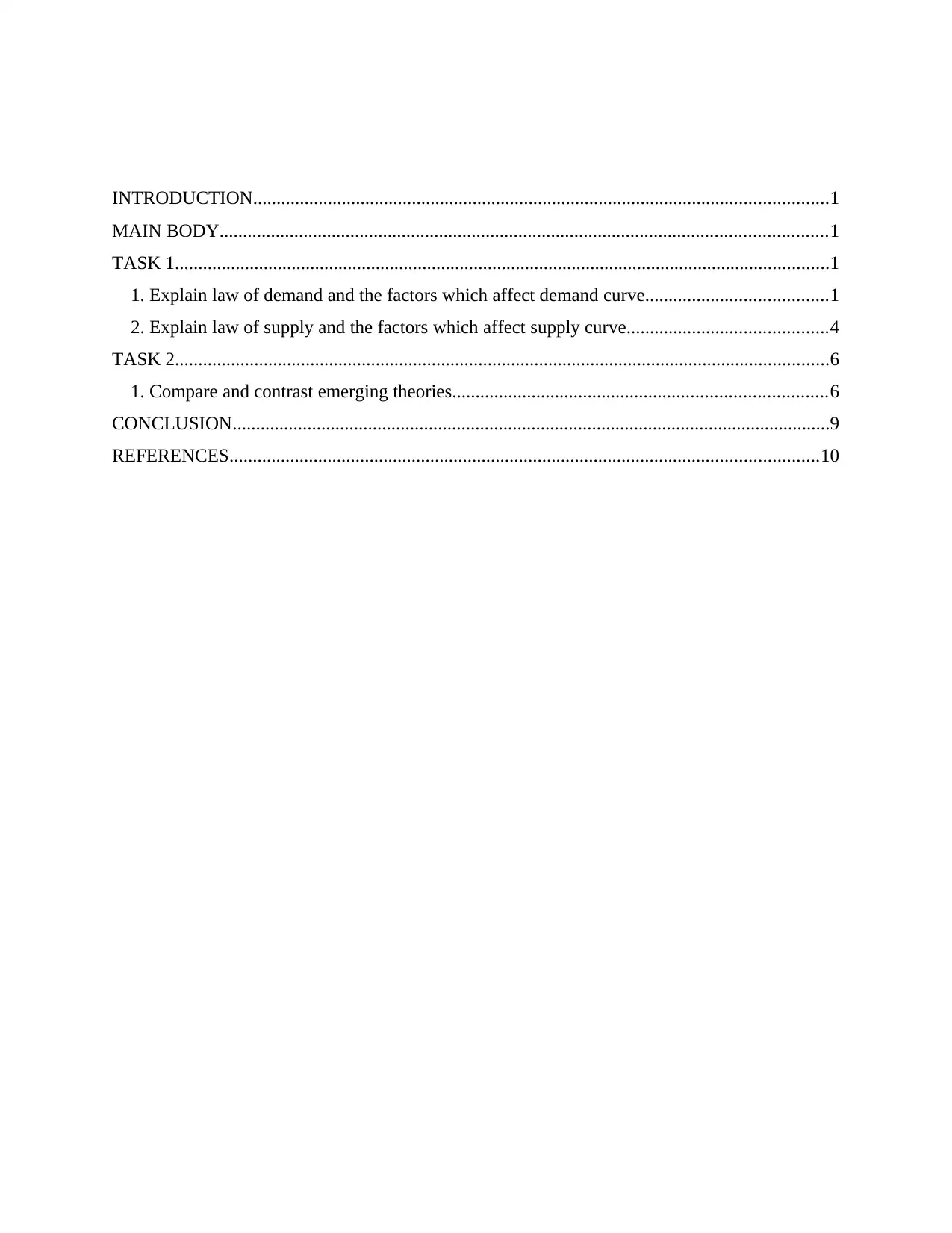
INTRODUCTION...........................................................................................................................1
MAIN BODY..................................................................................................................................1
TASK 1............................................................................................................................................1
1. Explain law of demand and the factors which affect demand curve.......................................1
2. Explain law of supply and the factors which affect supply curve...........................................4
TASK 2............................................................................................................................................6
1. Compare and contrast emerging theories................................................................................6
CONCLUSION................................................................................................................................9
REFERENCES..............................................................................................................................10
MAIN BODY..................................................................................................................................1
TASK 1............................................................................................................................................1
1. Explain law of demand and the factors which affect demand curve.......................................1
2. Explain law of supply and the factors which affect supply curve...........................................4
TASK 2............................................................................................................................................6
1. Compare and contrast emerging theories................................................................................6
CONCLUSION................................................................................................................................9
REFERENCES..............................................................................................................................10
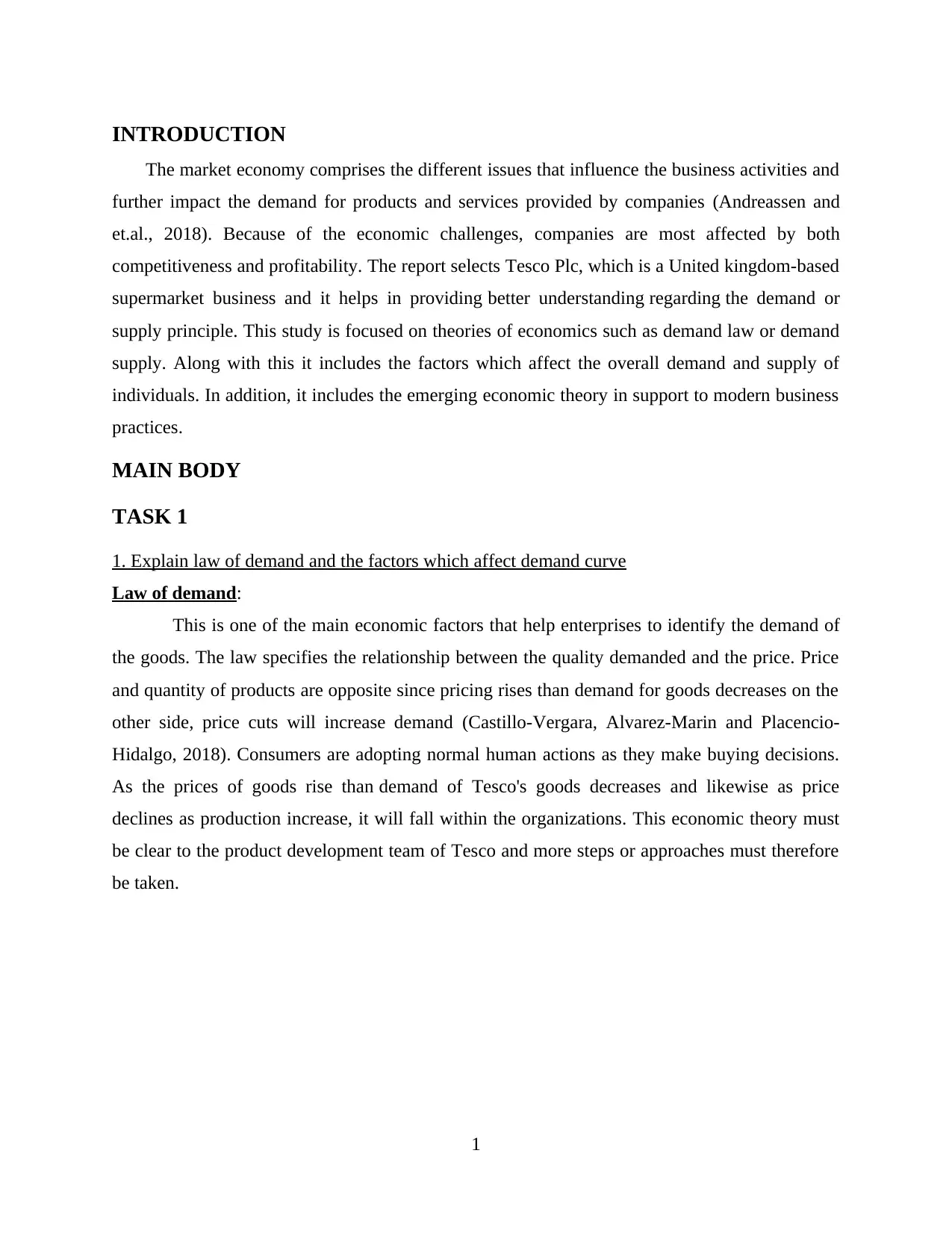
INTRODUCTION
The market economy comprises the different issues that influence the business activities and
further impact the demand for products and services provided by companies (Andreassen and
et.al., 2018). Because of the economic challenges, companies are most affected by both
competitiveness and profitability. The report selects Tesco Plc, which is a United kingdom-based
supermarket business and it helps in providing better understanding regarding the demand or
supply principle. This study is focused on theories of economics such as demand law or demand
supply. Along with this it includes the factors which affect the overall demand and supply of
individuals. In addition, it includes the emerging economic theory in support to modern business
practices.
MAIN BODY
TASK 1
1. Explain law of demand and the factors which affect demand curve
Law of demand:
This is one of the main economic factors that help enterprises to identify the demand of
the goods. The law specifies the relationship between the quality demanded and the price. Price
and quantity of products are opposite since pricing rises than demand for goods decreases on the
other side, price cuts will increase demand (Castillo-Vergara, Alvarez-Marin and Placencio-
Hidalgo, 2018). Consumers are adopting normal human actions as they make buying decisions.
As the prices of goods rise than demand of Tesco's goods decreases and likewise as price
declines as production increase, it will fall within the organizations. This economic theory must
be clear to the product development team of Tesco and more steps or approaches must therefore
be taken.
1
The market economy comprises the different issues that influence the business activities and
further impact the demand for products and services provided by companies (Andreassen and
et.al., 2018). Because of the economic challenges, companies are most affected by both
competitiveness and profitability. The report selects Tesco Plc, which is a United kingdom-based
supermarket business and it helps in providing better understanding regarding the demand or
supply principle. This study is focused on theories of economics such as demand law or demand
supply. Along with this it includes the factors which affect the overall demand and supply of
individuals. In addition, it includes the emerging economic theory in support to modern business
practices.
MAIN BODY
TASK 1
1. Explain law of demand and the factors which affect demand curve
Law of demand:
This is one of the main economic factors that help enterprises to identify the demand of
the goods. The law specifies the relationship between the quality demanded and the price. Price
and quantity of products are opposite since pricing rises than demand for goods decreases on the
other side, price cuts will increase demand (Castillo-Vergara, Alvarez-Marin and Placencio-
Hidalgo, 2018). Consumers are adopting normal human actions as they make buying decisions.
As the prices of goods rise than demand of Tesco's goods decreases and likewise as price
declines as production increase, it will fall within the organizations. This economic theory must
be clear to the product development team of Tesco and more steps or approaches must therefore
be taken.
1
⊘ This is a preview!⊘
Do you want full access?
Subscribe today to unlock all pages.

Trusted by 1+ million students worldwide
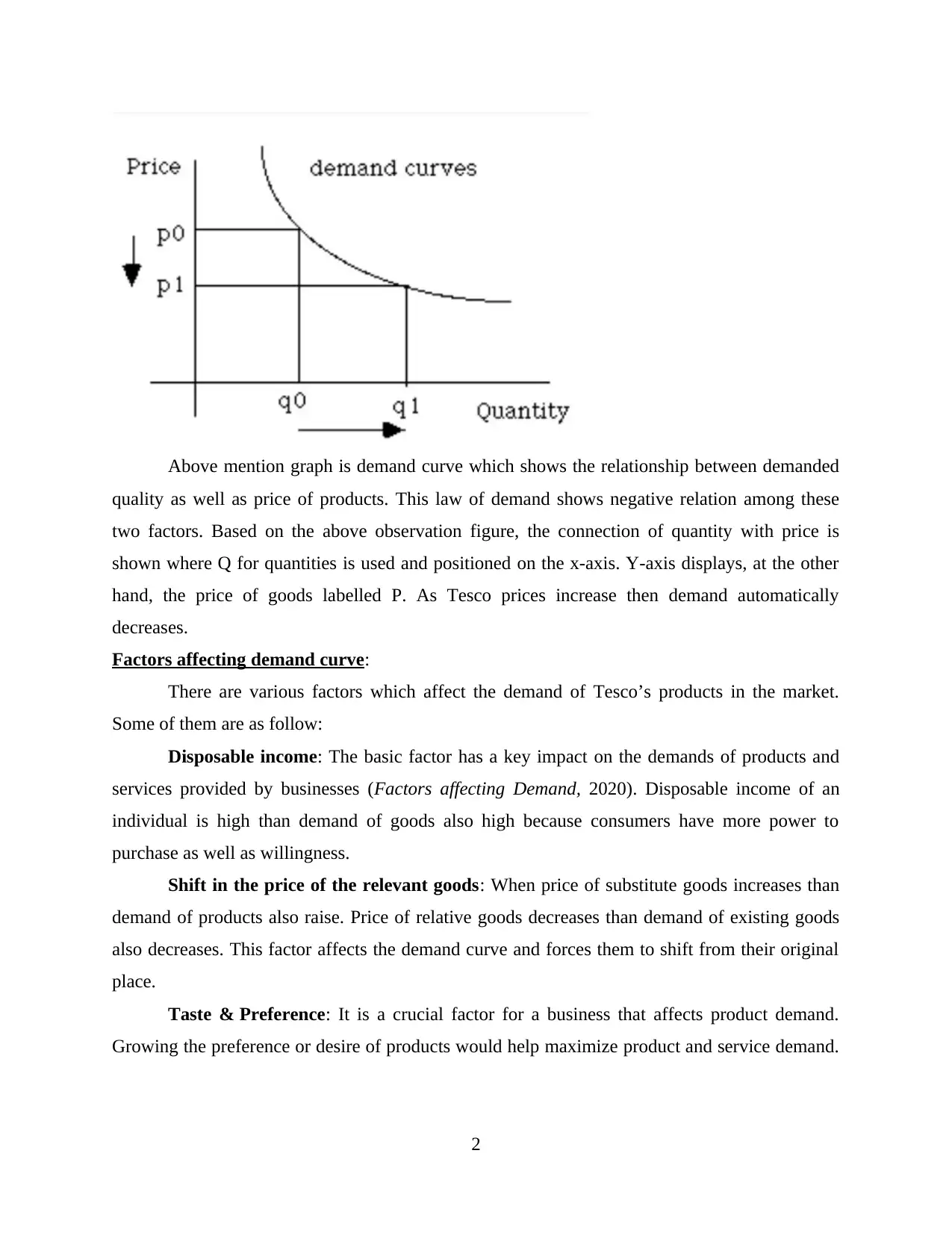
Above mention graph is demand curve which shows the relationship between demanded
quality as well as price of products. This law of demand shows negative relation among these
two factors. Based on the above observation figure, the connection of quantity with price is
shown where Q for quantities is used and positioned on the x-axis. Y-axis displays, at the other
hand, the price of goods labelled P. As Tesco prices increase then demand automatically
decreases.
Factors affecting demand curve:
There are various factors which affect the demand of Tesco’s products in the market.
Some of them are as follow:
Disposable income: The basic factor has a key impact on the demands of products and
services provided by businesses (Factors affecting Demand, 2020). Disposable income of an
individual is high than demand of goods also high because consumers have more power to
purchase as well as willingness.
Shift in the price of the relevant goods: When price of substitute goods increases than
demand of products also raise. Price of relative goods decreases than demand of existing goods
also decreases. This factor affects the demand curve and forces them to shift from their original
place.
Taste & Preference: It is a crucial factor for a business that affects product demand.
Growing the preference or desire of products would help maximize product and service demand.
2
quality as well as price of products. This law of demand shows negative relation among these
two factors. Based on the above observation figure, the connection of quantity with price is
shown where Q for quantities is used and positioned on the x-axis. Y-axis displays, at the other
hand, the price of goods labelled P. As Tesco prices increase then demand automatically
decreases.
Factors affecting demand curve:
There are various factors which affect the demand of Tesco’s products in the market.
Some of them are as follow:
Disposable income: The basic factor has a key impact on the demands of products and
services provided by businesses (Factors affecting Demand, 2020). Disposable income of an
individual is high than demand of goods also high because consumers have more power to
purchase as well as willingness.
Shift in the price of the relevant goods: When price of substitute goods increases than
demand of products also raise. Price of relative goods decreases than demand of existing goods
also decreases. This factor affects the demand curve and forces them to shift from their original
place.
Taste & Preference: It is a crucial factor for a business that affects product demand.
Growing the preference or desire of products would help maximize product and service demand.
2
Paraphrase This Document
Need a fresh take? Get an instant paraphrase of this document with our AI Paraphraser
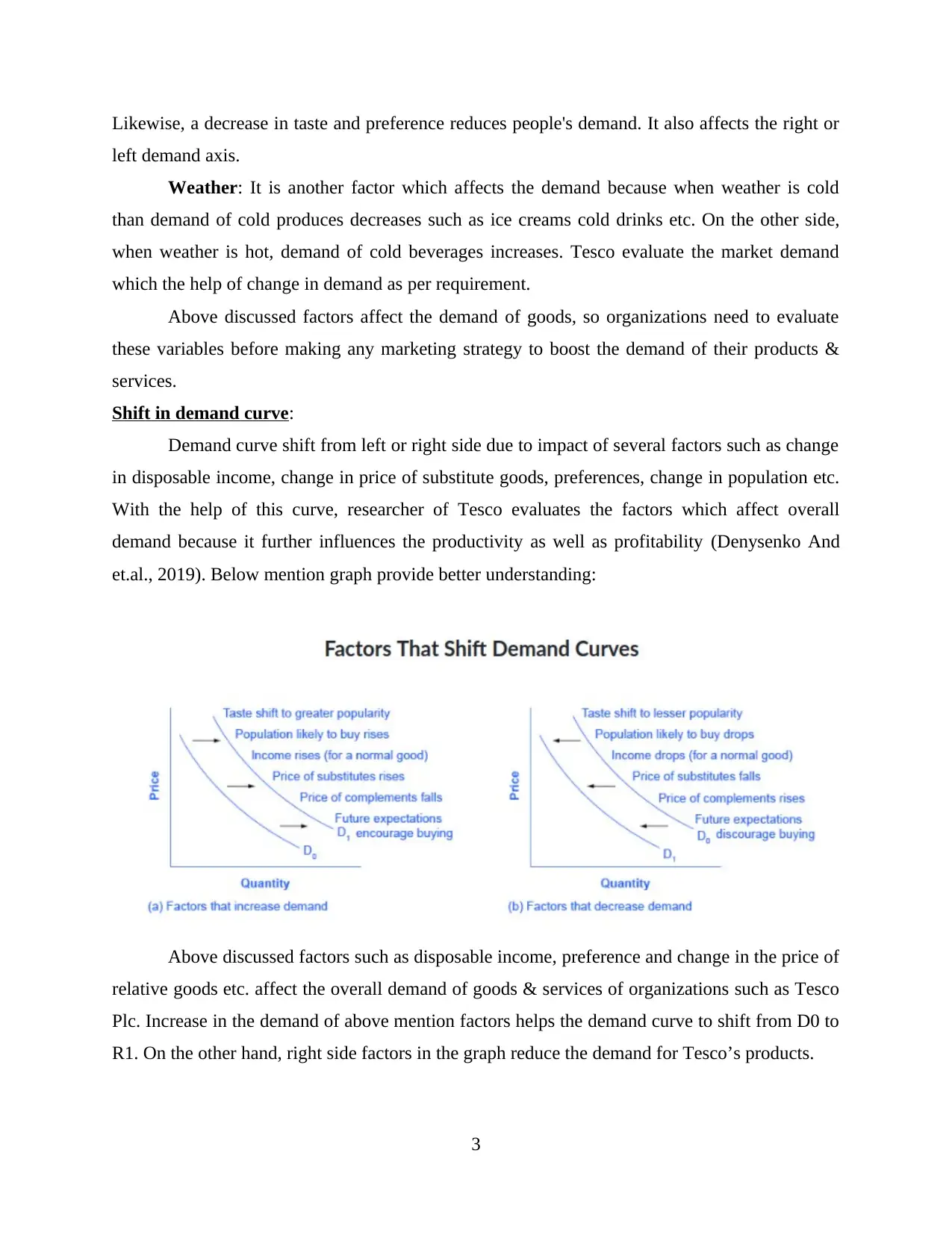
Likewise, a decrease in taste and preference reduces people's demand. It also affects the right or
left demand axis.
Weather: It is another factor which affects the demand because when weather is cold
than demand of cold produces decreases such as ice creams cold drinks etc. On the other side,
when weather is hot, demand of cold beverages increases. Tesco evaluate the market demand
which the help of change in demand as per requirement.
Above discussed factors affect the demand of goods, so organizations need to evaluate
these variables before making any marketing strategy to boost the demand of their products &
services.
Shift in demand curve:
Demand curve shift from left or right side due to impact of several factors such as change
in disposable income, change in price of substitute goods, preferences, change in population etc.
With the help of this curve, researcher of Tesco evaluates the factors which affect overall
demand because it further influences the productivity as well as profitability (Denysenko And
et.al., 2019). Below mention graph provide better understanding:
Above discussed factors such as disposable income, preference and change in the price of
relative goods etc. affect the overall demand of goods & services of organizations such as Tesco
Plc. Increase in the demand of above mention factors helps the demand curve to shift from D0 to
R1. On the other hand, right side factors in the graph reduce the demand for Tesco’s products.
3
left demand axis.
Weather: It is another factor which affects the demand because when weather is cold
than demand of cold produces decreases such as ice creams cold drinks etc. On the other side,
when weather is hot, demand of cold beverages increases. Tesco evaluate the market demand
which the help of change in demand as per requirement.
Above discussed factors affect the demand of goods, so organizations need to evaluate
these variables before making any marketing strategy to boost the demand of their products &
services.
Shift in demand curve:
Demand curve shift from left or right side due to impact of several factors such as change
in disposable income, change in price of substitute goods, preferences, change in population etc.
With the help of this curve, researcher of Tesco evaluates the factors which affect overall
demand because it further influences the productivity as well as profitability (Denysenko And
et.al., 2019). Below mention graph provide better understanding:
Above discussed factors such as disposable income, preference and change in the price of
relative goods etc. affect the overall demand of goods & services of organizations such as Tesco
Plc. Increase in the demand of above mention factors helps the demand curve to shift from D0 to
R1. On the other hand, right side factors in the graph reduce the demand for Tesco’s products.
3
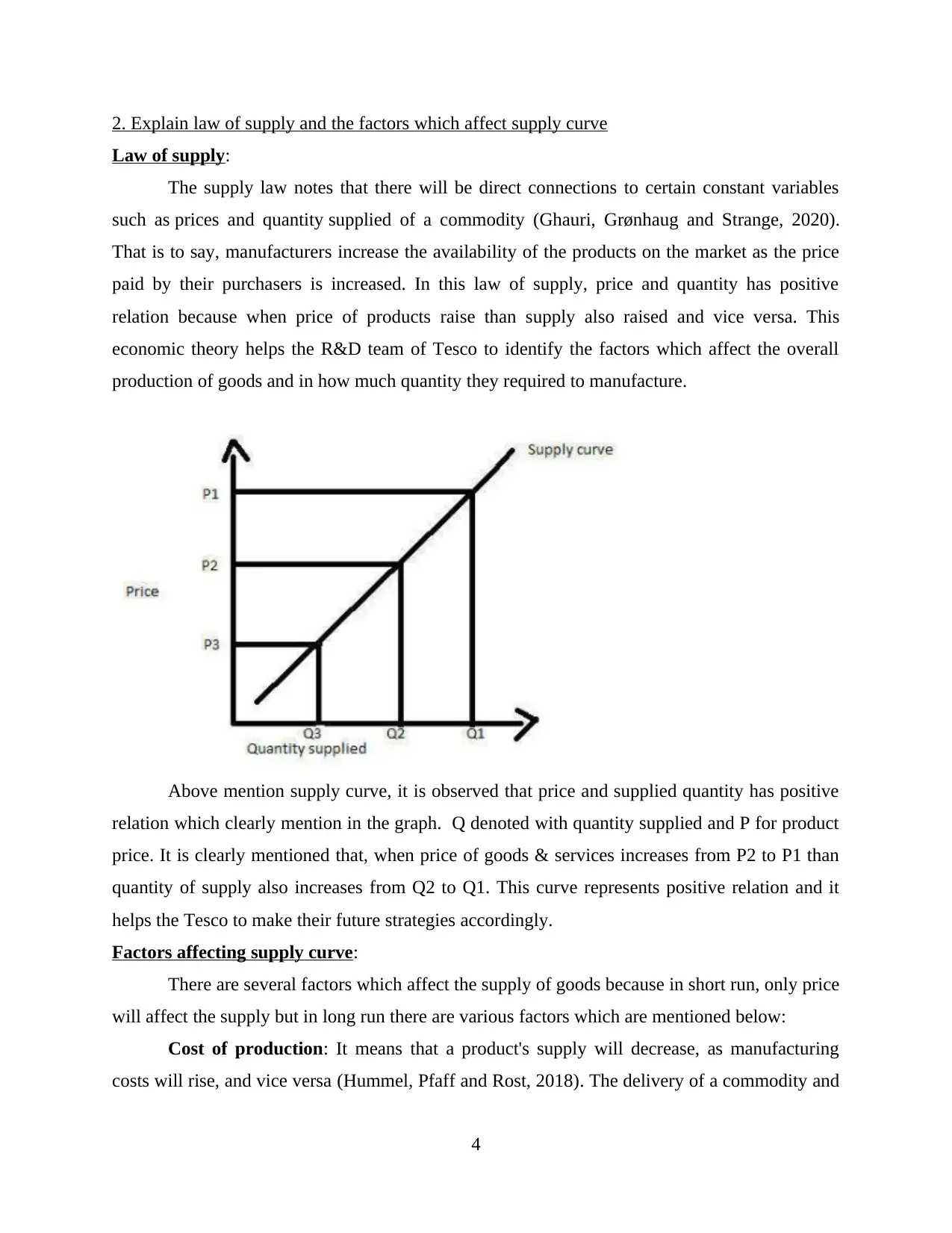
2. Explain law of supply and the factors which affect supply curve
Law of supply:
The supply law notes that there will be direct connections to certain constant variables
such as prices and quantity supplied of a commodity (Ghauri, Grønhaug and Strange, 2020).
That is to say, manufacturers increase the availability of the products on the market as the price
paid by their purchasers is increased. In this law of supply, price and quantity has positive
relation because when price of products raise than supply also raised and vice versa. This
economic theory helps the R&D team of Tesco to identify the factors which affect the overall
production of goods and in how much quantity they required to manufacture.
Above mention supply curve, it is observed that price and supplied quantity has positive
relation which clearly mention in the graph. Q denoted with quantity supplied and P for product
price. It is clearly mentioned that, when price of goods & services increases from P2 to P1 than
quantity of supply also increases from Q2 to Q1. This curve represents positive relation and it
helps the Tesco to make their future strategies accordingly.
Factors affecting supply curve:
There are several factors which affect the supply of goods because in short run, only price
will affect the supply but in long run there are various factors which are mentioned below:
Cost of production: It means that a product's supply will decrease, as manufacturing
costs will rise, and vice versa (Hummel, Pfaff and Rost, 2018). The delivery of a commodity and
4
Law of supply:
The supply law notes that there will be direct connections to certain constant variables
such as prices and quantity supplied of a commodity (Ghauri, Grønhaug and Strange, 2020).
That is to say, manufacturers increase the availability of the products on the market as the price
paid by their purchasers is increased. In this law of supply, price and quantity has positive
relation because when price of products raise than supply also raised and vice versa. This
economic theory helps the R&D team of Tesco to identify the factors which affect the overall
production of goods and in how much quantity they required to manufacture.
Above mention supply curve, it is observed that price and supplied quantity has positive
relation which clearly mention in the graph. Q denoted with quantity supplied and P for product
price. It is clearly mentioned that, when price of goods & services increases from P2 to P1 than
quantity of supply also increases from Q2 to Q1. This curve represents positive relation and it
helps the Tesco to make their future strategies accordingly.
Factors affecting supply curve:
There are several factors which affect the supply of goods because in short run, only price
will affect the supply but in long run there are various factors which are mentioned below:
Cost of production: It means that a product's supply will decrease, as manufacturing
costs will rise, and vice versa (Hummel, Pfaff and Rost, 2018). The delivery of a commodity and
4
⊘ This is a preview!⊘
Do you want full access?
Subscribe today to unlock all pages.

Trusted by 1+ million students worldwide
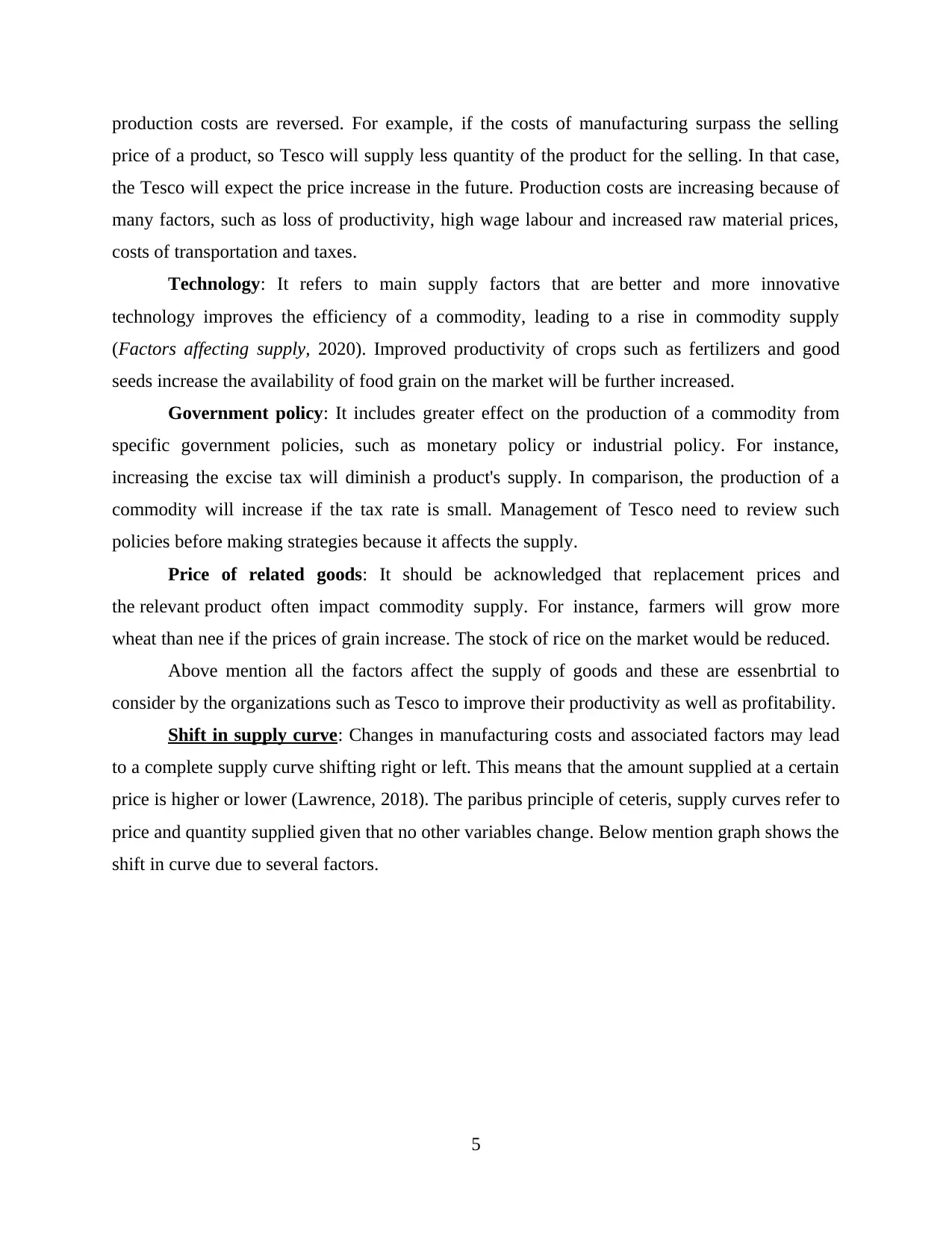
production costs are reversed. For example, if the costs of manufacturing surpass the selling
price of a product, so Tesco will supply less quantity of the product for the selling. In that case,
the Tesco will expect the price increase in the future. Production costs are increasing because of
many factors, such as loss of productivity, high wage labour and increased raw material prices,
costs of transportation and taxes.
Technology: It refers to main supply factors that are better and more innovative
technology improves the efficiency of a commodity, leading to a rise in commodity supply
(Factors affecting supply, 2020). Improved productivity of crops such as fertilizers and good
seeds increase the availability of food grain on the market will be further increased.
Government policy: It includes greater effect on the production of a commodity from
specific government policies, such as monetary policy or industrial policy. For instance,
increasing the excise tax will diminish a product's supply. In comparison, the production of a
commodity will increase if the tax rate is small. Management of Tesco need to review such
policies before making strategies because it affects the supply.
Price of related goods: It should be acknowledged that replacement prices and
the relevant product often impact commodity supply. For instance, farmers will grow more
wheat than nee if the prices of grain increase. The stock of rice on the market would be reduced.
Above mention all the factors affect the supply of goods and these are essenbrtial to
consider by the organizations such as Tesco to improve their productivity as well as profitability.
Shift in supply curve: Changes in manufacturing costs and associated factors may lead
to a complete supply curve shifting right or left. This means that the amount supplied at a certain
price is higher or lower (Lawrence, 2018). The paribus principle of ceteris, supply curves refer to
price and quantity supplied given that no other variables change. Below mention graph shows the
shift in curve due to several factors.
5
price of a product, so Tesco will supply less quantity of the product for the selling. In that case,
the Tesco will expect the price increase in the future. Production costs are increasing because of
many factors, such as loss of productivity, high wage labour and increased raw material prices,
costs of transportation and taxes.
Technology: It refers to main supply factors that are better and more innovative
technology improves the efficiency of a commodity, leading to a rise in commodity supply
(Factors affecting supply, 2020). Improved productivity of crops such as fertilizers and good
seeds increase the availability of food grain on the market will be further increased.
Government policy: It includes greater effect on the production of a commodity from
specific government policies, such as monetary policy or industrial policy. For instance,
increasing the excise tax will diminish a product's supply. In comparison, the production of a
commodity will increase if the tax rate is small. Management of Tesco need to review such
policies before making strategies because it affects the supply.
Price of related goods: It should be acknowledged that replacement prices and
the relevant product often impact commodity supply. For instance, farmers will grow more
wheat than nee if the prices of grain increase. The stock of rice on the market would be reduced.
Above mention all the factors affect the supply of goods and these are essenbrtial to
consider by the organizations such as Tesco to improve their productivity as well as profitability.
Shift in supply curve: Changes in manufacturing costs and associated factors may lead
to a complete supply curve shifting right or left. This means that the amount supplied at a certain
price is higher or lower (Lawrence, 2018). The paribus principle of ceteris, supply curves refer to
price and quantity supplied given that no other variables change. Below mention graph shows the
shift in curve due to several factors.
5
Paraphrase This Document
Need a fresh take? Get an instant paraphrase of this document with our AI Paraphraser
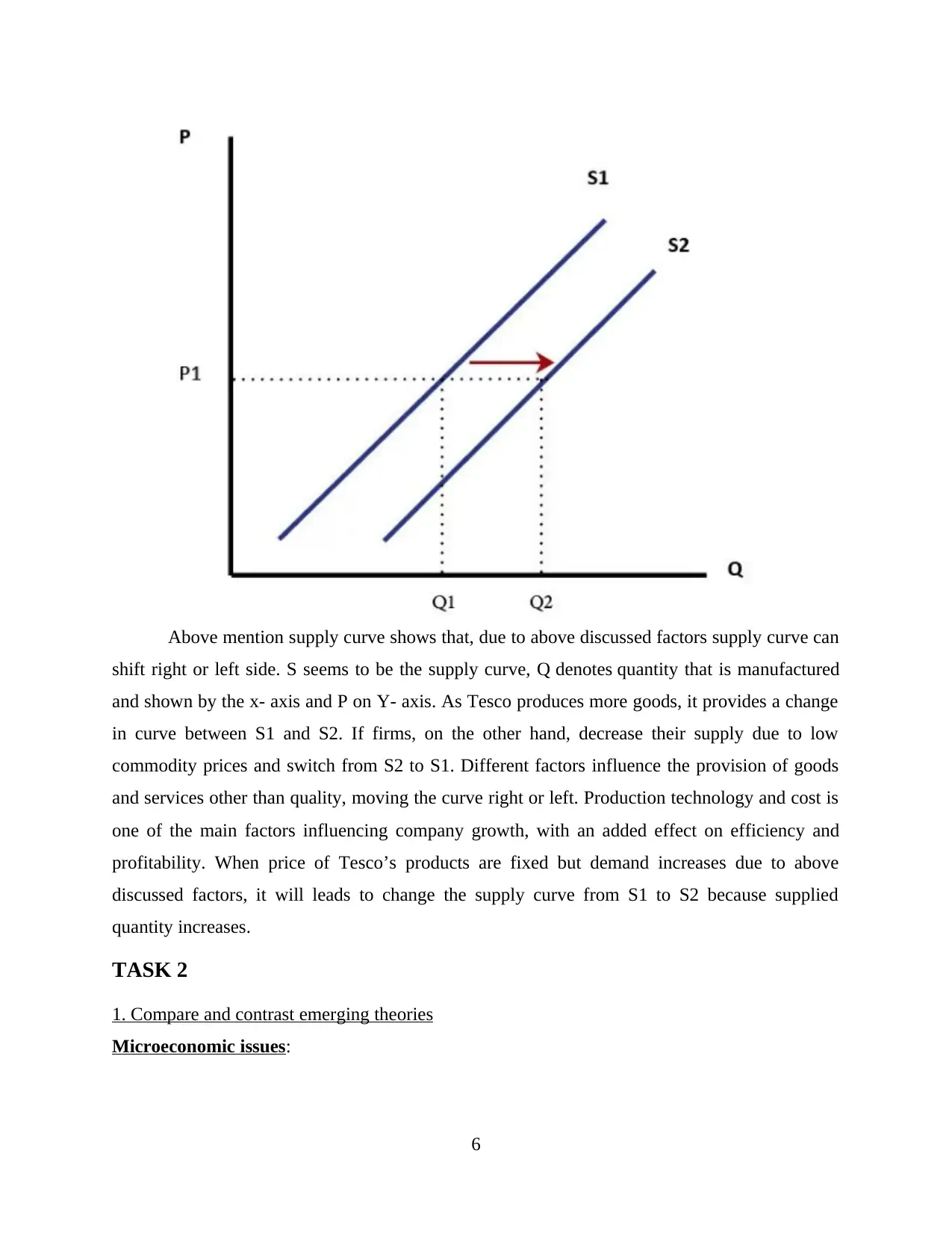
Above mention supply curve shows that, due to above discussed factors supply curve can
shift right or left side. S seems to be the supply curve, Q denotes quantity that is manufactured
and shown by the x- axis and P on Y- axis. As Tesco produces more goods, it provides a change
in curve between S1 and S2. If firms, on the other hand, decrease their supply due to low
commodity prices and switch from S2 to S1. Different factors influence the provision of goods
and services other than quality, moving the curve right or left. Production technology and cost is
one of the main factors influencing company growth, with an added effect on efficiency and
profitability. When price of Tesco’s products are fixed but demand increases due to above
discussed factors, it will leads to change the supply curve from S1 to S2 because supplied
quantity increases.
TASK 2
1. Compare and contrast emerging theories
Microeconomic issues:
6
shift right or left side. S seems to be the supply curve, Q denotes quantity that is manufactured
and shown by the x- axis and P on Y- axis. As Tesco produces more goods, it provides a change
in curve between S1 and S2. If firms, on the other hand, decrease their supply due to low
commodity prices and switch from S2 to S1. Different factors influence the provision of goods
and services other than quality, moving the curve right or left. Production technology and cost is
one of the main factors influencing company growth, with an added effect on efficiency and
profitability. When price of Tesco’s products are fixed but demand increases due to above
discussed factors, it will leads to change the supply curve from S1 to S2 because supplied
quantity increases.
TASK 2
1. Compare and contrast emerging theories
Microeconomic issues:
6
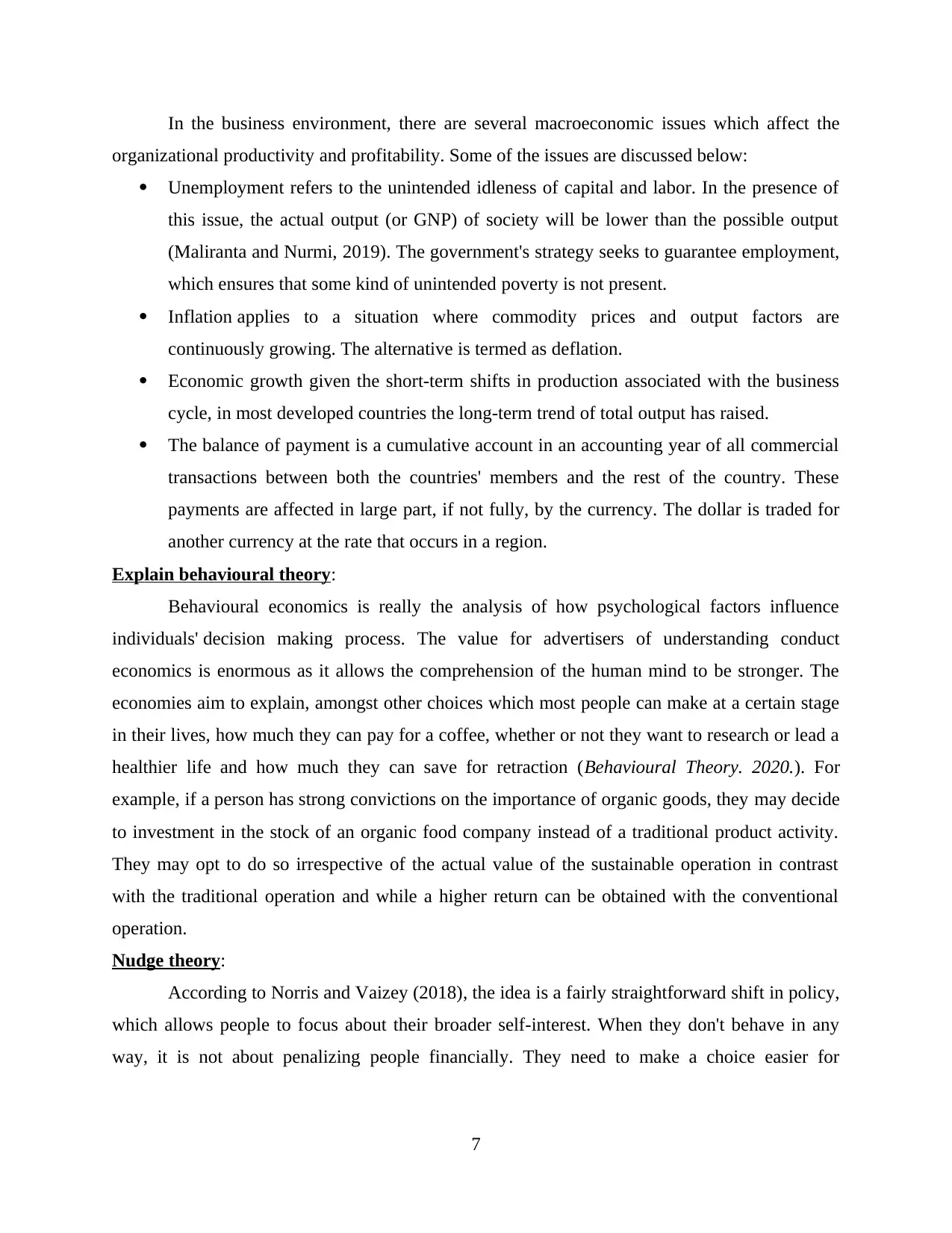
In the business environment, there are several macroeconomic issues which affect the
organizational productivity and profitability. Some of the issues are discussed below:
Unemployment refers to the unintended idleness of capital and labor. In the presence of
this issue, the actual output (or GNP) of society will be lower than the possible output
(Maliranta and Nurmi, 2019). The government's strategy seeks to guarantee employment,
which ensures that some kind of unintended poverty is not present.
Inflation applies to a situation where commodity prices and output factors are
continuously growing. The alternative is termed as deflation.
Economic growth given the short-term shifts in production associated with the business
cycle, in most developed countries the long-term trend of total output has raised.
The balance of payment is a cumulative account in an accounting year of all commercial
transactions between both the countries' members and the rest of the country. These
payments are affected in large part, if not fully, by the currency. The dollar is traded for
another currency at the rate that occurs in a region.
Explain behavioural theory:
Behavioural economics is really the analysis of how psychological factors influence
individuals' decision making process. The value for advertisers of understanding conduct
economics is enormous as it allows the comprehension of the human mind to be stronger. The
economies aim to explain, amongst other choices which most people can make at a certain stage
in their lives, how much they can pay for a coffee, whether or not they want to research or lead a
healthier life and how much they can save for retraction (Behavioural Theory. 2020.). For
example, if a person has strong convictions on the importance of organic goods, they may decide
to investment in the stock of an organic food company instead of a traditional product activity.
They may opt to do so irrespective of the actual value of the sustainable operation in contrast
with the traditional operation and while a higher return can be obtained with the conventional
operation.
Nudge theory:
According to Norris and Vaizey (2018), the idea is a fairly straightforward shift in policy,
which allows people to focus about their broader self-interest. When they don't behave in any
way, it is not about penalizing people financially. They need to make a choice easier for
7
organizational productivity and profitability. Some of the issues are discussed below:
Unemployment refers to the unintended idleness of capital and labor. In the presence of
this issue, the actual output (or GNP) of society will be lower than the possible output
(Maliranta and Nurmi, 2019). The government's strategy seeks to guarantee employment,
which ensures that some kind of unintended poverty is not present.
Inflation applies to a situation where commodity prices and output factors are
continuously growing. The alternative is termed as deflation.
Economic growth given the short-term shifts in production associated with the business
cycle, in most developed countries the long-term trend of total output has raised.
The balance of payment is a cumulative account in an accounting year of all commercial
transactions between both the countries' members and the rest of the country. These
payments are affected in large part, if not fully, by the currency. The dollar is traded for
another currency at the rate that occurs in a region.
Explain behavioural theory:
Behavioural economics is really the analysis of how psychological factors influence
individuals' decision making process. The value for advertisers of understanding conduct
economics is enormous as it allows the comprehension of the human mind to be stronger. The
economies aim to explain, amongst other choices which most people can make at a certain stage
in their lives, how much they can pay for a coffee, whether or not they want to research or lead a
healthier life and how much they can save for retraction (Behavioural Theory. 2020.). For
example, if a person has strong convictions on the importance of organic goods, they may decide
to investment in the stock of an organic food company instead of a traditional product activity.
They may opt to do so irrespective of the actual value of the sustainable operation in contrast
with the traditional operation and while a higher return can be obtained with the conventional
operation.
Nudge theory:
According to Norris and Vaizey (2018), the idea is a fairly straightforward shift in policy,
which allows people to focus about their broader self-interest. When they don't behave in any
way, it is not about penalizing people financially. They need to make a choice easier for
7
⊘ This is a preview!⊘
Do you want full access?
Subscribe today to unlock all pages.

Trusted by 1+ million students worldwide
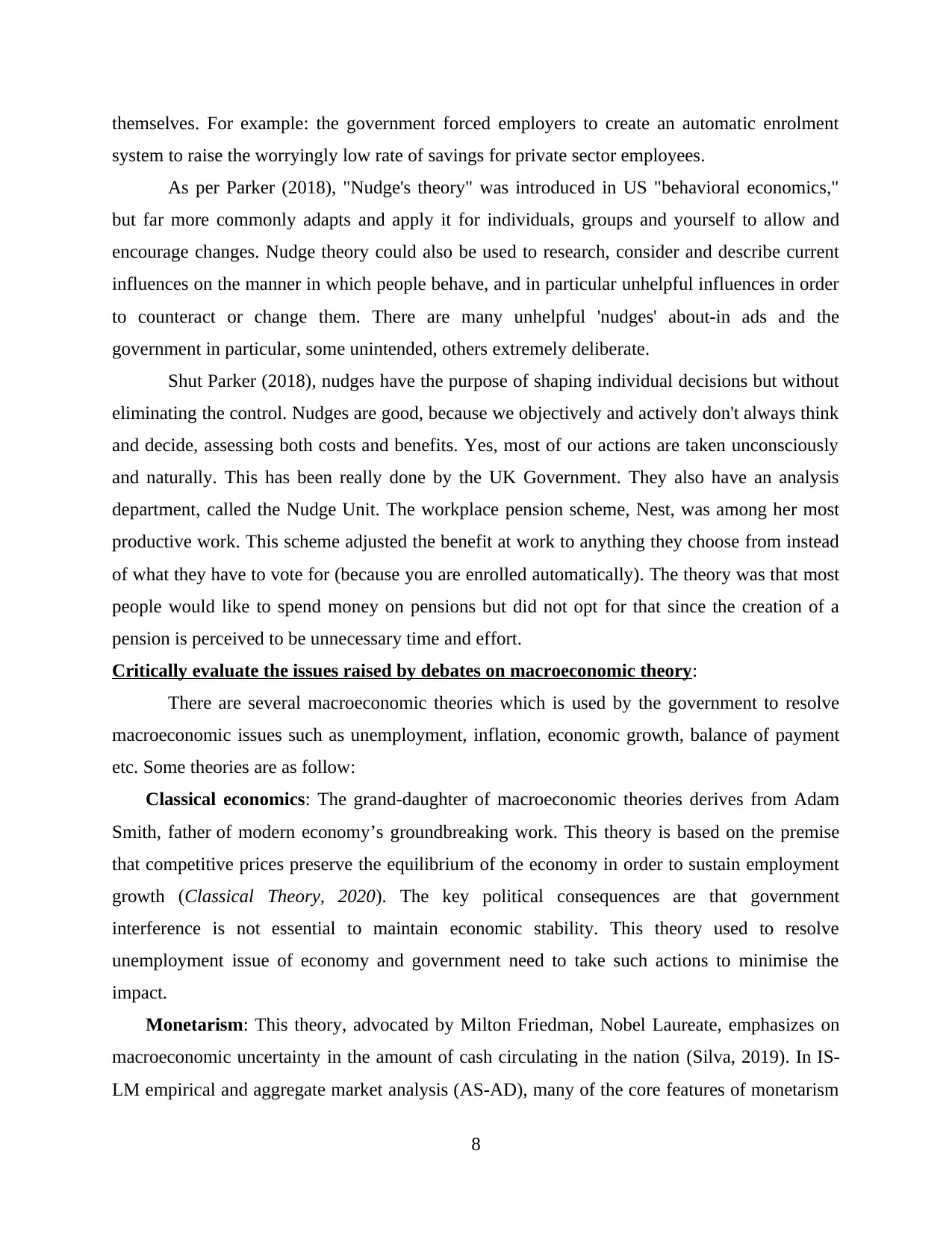
themselves. For example: the government forced employers to create an automatic enrolment
system to raise the worryingly low rate of savings for private sector employees.
As per Parker (2018), "Nudge's theory" was introduced in US "behavioral economics,"
but far more commonly adapts and apply it for individuals, groups and yourself to allow and
encourage changes. Nudge theory could also be used to research, consider and describe current
influences on the manner in which people behave, and in particular unhelpful influences in order
to counteract or change them. There are many unhelpful 'nudges' about-in ads and the
government in particular, some unintended, others extremely deliberate.
Shut Parker (2018), nudges have the purpose of shaping individual decisions but without
eliminating the control. Nudges are good, because we objectively and actively don't always think
and decide, assessing both costs and benefits. Yes, most of our actions are taken unconsciously
and naturally. This has been really done by the UK Government. They also have an analysis
department, called the Nudge Unit. The workplace pension scheme, Nest, was among her most
productive work. This scheme adjusted the benefit at work to anything they choose from instead
of what they have to vote for (because you are enrolled automatically). The theory was that most
people would like to spend money on pensions but did not opt for that since the creation of a
pension is perceived to be unnecessary time and effort.
Critically evaluate the issues raised by debates on macroeconomic theory:
There are several macroeconomic theories which is used by the government to resolve
macroeconomic issues such as unemployment, inflation, economic growth, balance of payment
etc. Some theories are as follow:
Classical economics: The grand-daughter of macroeconomic theories derives from Adam
Smith, father of modern economy’s groundbreaking work. This theory is based on the premise
that competitive prices preserve the equilibrium of the economy in order to sustain employment
growth (Classical Theory, 2020). The key political consequences are that government
interference is not essential to maintain economic stability. This theory used to resolve
unemployment issue of economy and government need to take such actions to minimise the
impact.
Monetarism: This theory, advocated by Milton Friedman, Nobel Laureate, emphasizes on
macroeconomic uncertainty in the amount of cash circulating in the nation (Silva, 2019). In IS-
LM empirical and aggregate market analysis (AS-AD), many of the core features of monetarism
8
system to raise the worryingly low rate of savings for private sector employees.
As per Parker (2018), "Nudge's theory" was introduced in US "behavioral economics,"
but far more commonly adapts and apply it for individuals, groups and yourself to allow and
encourage changes. Nudge theory could also be used to research, consider and describe current
influences on the manner in which people behave, and in particular unhelpful influences in order
to counteract or change them. There are many unhelpful 'nudges' about-in ads and the
government in particular, some unintended, others extremely deliberate.
Shut Parker (2018), nudges have the purpose of shaping individual decisions but without
eliminating the control. Nudges are good, because we objectively and actively don't always think
and decide, assessing both costs and benefits. Yes, most of our actions are taken unconsciously
and naturally. This has been really done by the UK Government. They also have an analysis
department, called the Nudge Unit. The workplace pension scheme, Nest, was among her most
productive work. This scheme adjusted the benefit at work to anything they choose from instead
of what they have to vote for (because you are enrolled automatically). The theory was that most
people would like to spend money on pensions but did not opt for that since the creation of a
pension is perceived to be unnecessary time and effort.
Critically evaluate the issues raised by debates on macroeconomic theory:
There are several macroeconomic theories which is used by the government to resolve
macroeconomic issues such as unemployment, inflation, economic growth, balance of payment
etc. Some theories are as follow:
Classical economics: The grand-daughter of macroeconomic theories derives from Adam
Smith, father of modern economy’s groundbreaking work. This theory is based on the premise
that competitive prices preserve the equilibrium of the economy in order to sustain employment
growth (Classical Theory, 2020). The key political consequences are that government
interference is not essential to maintain economic stability. This theory used to resolve
unemployment issue of economy and government need to take such actions to minimise the
impact.
Monetarism: This theory, advocated by Milton Friedman, Nobel Laureate, emphasizes on
macroeconomic uncertainty in the amount of cash circulating in the nation (Silva, 2019). In IS-
LM empirical and aggregate market analysis (AS-AD), many of the core features of monetarism
8
Paraphrase This Document
Need a fresh take? Get an instant paraphrase of this document with our AI Paraphraser
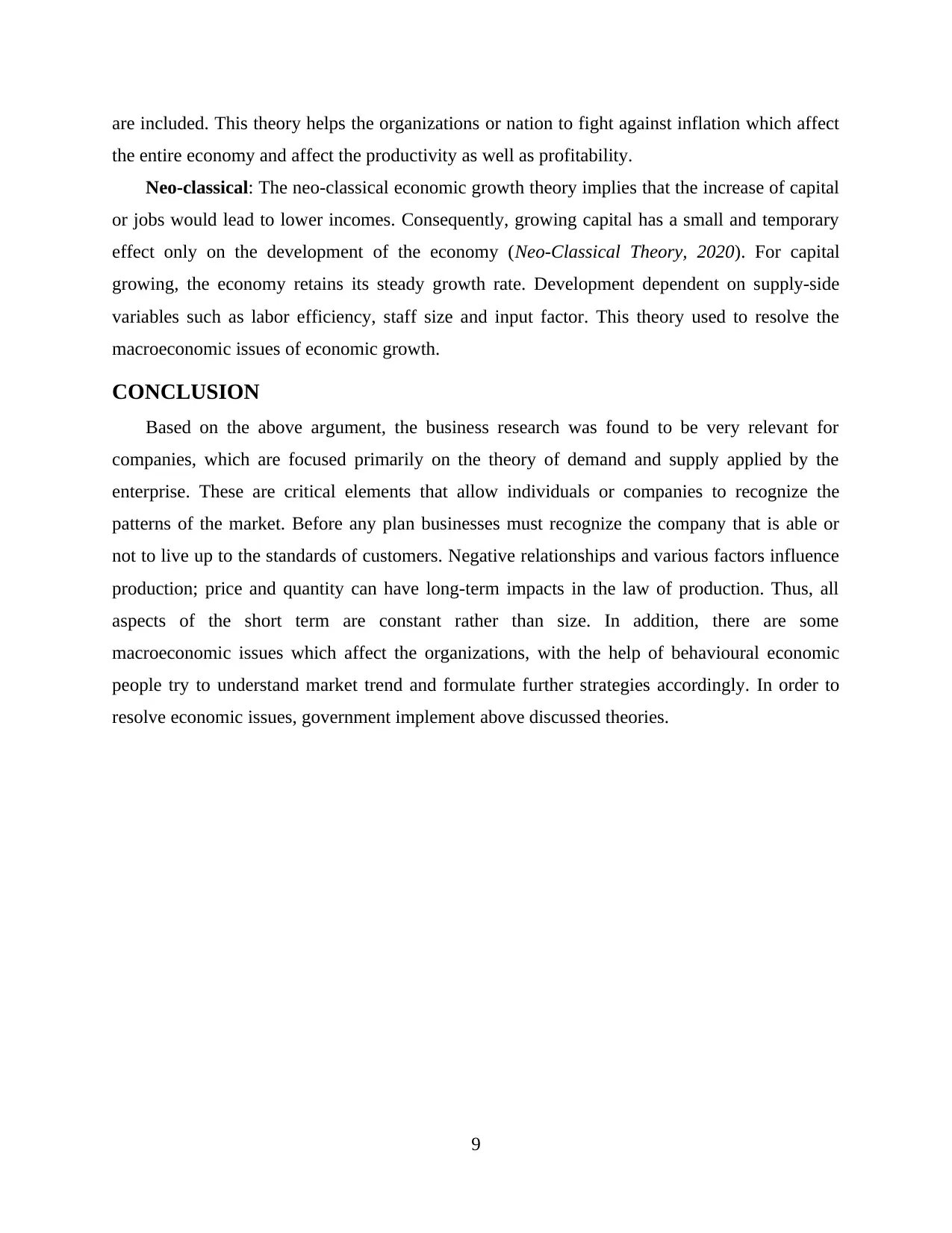
are included. This theory helps the organizations or nation to fight against inflation which affect
the entire economy and affect the productivity as well as profitability.
Neo-classical: The neo-classical economic growth theory implies that the increase of capital
or jobs would lead to lower incomes. Consequently, growing capital has a small and temporary
effect only on the development of the economy (Neo-Classical Theory, 2020). For capital
growing, the economy retains its steady growth rate. Development dependent on supply-side
variables such as labor efficiency, staff size and input factor. This theory used to resolve the
macroeconomic issues of economic growth.
CONCLUSION
Based on the above argument, the business research was found to be very relevant for
companies, which are focused primarily on the theory of demand and supply applied by the
enterprise. These are critical elements that allow individuals or companies to recognize the
patterns of the market. Before any plan businesses must recognize the company that is able or
not to live up to the standards of customers. Negative relationships and various factors influence
production; price and quantity can have long-term impacts in the law of production. Thus, all
aspects of the short term are constant rather than size. In addition, there are some
macroeconomic issues which affect the organizations, with the help of behavioural economic
people try to understand market trend and formulate further strategies accordingly. In order to
resolve economic issues, government implement above discussed theories.
9
the entire economy and affect the productivity as well as profitability.
Neo-classical: The neo-classical economic growth theory implies that the increase of capital
or jobs would lead to lower incomes. Consequently, growing capital has a small and temporary
effect only on the development of the economy (Neo-Classical Theory, 2020). For capital
growing, the economy retains its steady growth rate. Development dependent on supply-side
variables such as labor efficiency, staff size and input factor. This theory used to resolve the
macroeconomic issues of economic growth.
CONCLUSION
Based on the above argument, the business research was found to be very relevant for
companies, which are focused primarily on the theory of demand and supply applied by the
enterprise. These are critical elements that allow individuals or companies to recognize the
patterns of the market. Before any plan businesses must recognize the company that is able or
not to live up to the standards of customers. Negative relationships and various factors influence
production; price and quantity can have long-term impacts in the law of production. Thus, all
aspects of the short term are constant rather than size. In addition, there are some
macroeconomic issues which affect the organizations, with the help of behavioural economic
people try to understand market trend and formulate further strategies accordingly. In order to
resolve economic issues, government implement above discussed theories.
9
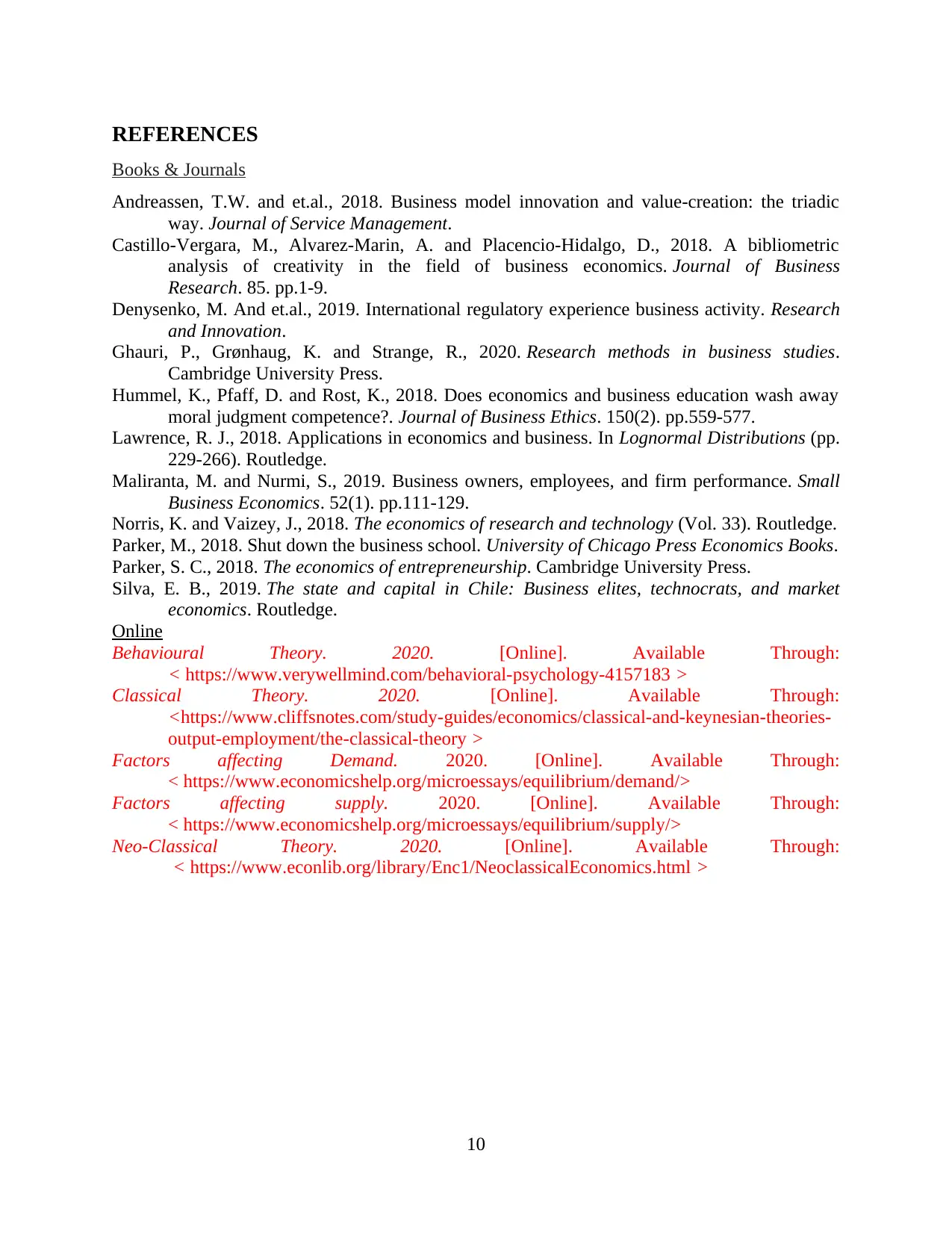
REFERENCES
Books & Journals
Andreassen, T.W. and et.al., 2018. Business model innovation and value-creation: the triadic
way. Journal of Service Management.
Castillo-Vergara, M., Alvarez-Marin, A. and Placencio-Hidalgo, D., 2018. A bibliometric
analysis of creativity in the field of business economics. Journal of Business
Research. 85. pp.1-9.
Denysenko, M. And et.al., 2019. International regulatory experience business activity. Research
and Innovation.
Ghauri, P., Grønhaug, K. and Strange, R., 2020. Research methods in business studies.
Cambridge University Press.
Hummel, K., Pfaff, D. and Rost, K., 2018. Does economics and business education wash away
moral judgment competence?. Journal of Business Ethics. 150(2). pp.559-577.
Lawrence, R. J., 2018. Applications in economics and business. In Lognormal Distributions (pp.
229-266). Routledge.
Maliranta, M. and Nurmi, S., 2019. Business owners, employees, and firm performance. Small
Business Economics. 52(1). pp.111-129.
Norris, K. and Vaizey, J., 2018. The economics of research and technology (Vol. 33). Routledge.
Parker, M., 2018. Shut down the business school. University of Chicago Press Economics Books.
Parker, S. C., 2018. The economics of entrepreneurship. Cambridge University Press.
Silva, E. B., 2019. The state and capital in Chile: Business elites, technocrats, and market
economics. Routledge.
Online
Behavioural Theory. 2020. [Online]. Available Through:
< https://www.verywellmind.com/behavioral-psychology-4157183 >
Classical Theory. 2020. [Online]. Available Through:
<https://www.cliffsnotes.com/study-guides/economics/classical-and-keynesian-theories-
output-employment/the-classical-theory >
Factors affecting Demand. 2020. [Online]. Available Through:
< https://www.economicshelp.org/microessays/equilibrium/demand/>
Factors affecting supply. 2020. [Online]. Available Through:
< https://www.economicshelp.org/microessays/equilibrium/supply/>
Neo-Classical Theory. 2020. [Online]. Available Through:
< https://www.econlib.org/library/Enc1/NeoclassicalEconomics.html >
10
Books & Journals
Andreassen, T.W. and et.al., 2018. Business model innovation and value-creation: the triadic
way. Journal of Service Management.
Castillo-Vergara, M., Alvarez-Marin, A. and Placencio-Hidalgo, D., 2018. A bibliometric
analysis of creativity in the field of business economics. Journal of Business
Research. 85. pp.1-9.
Denysenko, M. And et.al., 2019. International regulatory experience business activity. Research
and Innovation.
Ghauri, P., Grønhaug, K. and Strange, R., 2020. Research methods in business studies.
Cambridge University Press.
Hummel, K., Pfaff, D. and Rost, K., 2018. Does economics and business education wash away
moral judgment competence?. Journal of Business Ethics. 150(2). pp.559-577.
Lawrence, R. J., 2018. Applications in economics and business. In Lognormal Distributions (pp.
229-266). Routledge.
Maliranta, M. and Nurmi, S., 2019. Business owners, employees, and firm performance. Small
Business Economics. 52(1). pp.111-129.
Norris, K. and Vaizey, J., 2018. The economics of research and technology (Vol. 33). Routledge.
Parker, M., 2018. Shut down the business school. University of Chicago Press Economics Books.
Parker, S. C., 2018. The economics of entrepreneurship. Cambridge University Press.
Silva, E. B., 2019. The state and capital in Chile: Business elites, technocrats, and market
economics. Routledge.
Online
Behavioural Theory. 2020. [Online]. Available Through:
< https://www.verywellmind.com/behavioral-psychology-4157183 >
Classical Theory. 2020. [Online]. Available Through:
<https://www.cliffsnotes.com/study-guides/economics/classical-and-keynesian-theories-
output-employment/the-classical-theory >
Factors affecting Demand. 2020. [Online]. Available Through:
< https://www.economicshelp.org/microessays/equilibrium/demand/>
Factors affecting supply. 2020. [Online]. Available Through:
< https://www.economicshelp.org/microessays/equilibrium/supply/>
Neo-Classical Theory. 2020. [Online]. Available Through:
< https://www.econlib.org/library/Enc1/NeoclassicalEconomics.html >
10
⊘ This is a preview!⊘
Do you want full access?
Subscribe today to unlock all pages.

Trusted by 1+ million students worldwide
1 out of 12
Related Documents
Your All-in-One AI-Powered Toolkit for Academic Success.
+13062052269
info@desklib.com
Available 24*7 on WhatsApp / Email
![[object Object]](/_next/static/media/star-bottom.7253800d.svg)
Unlock your academic potential
Copyright © 2020–2025 A2Z Services. All Rights Reserved. Developed and managed by ZUCOL.



